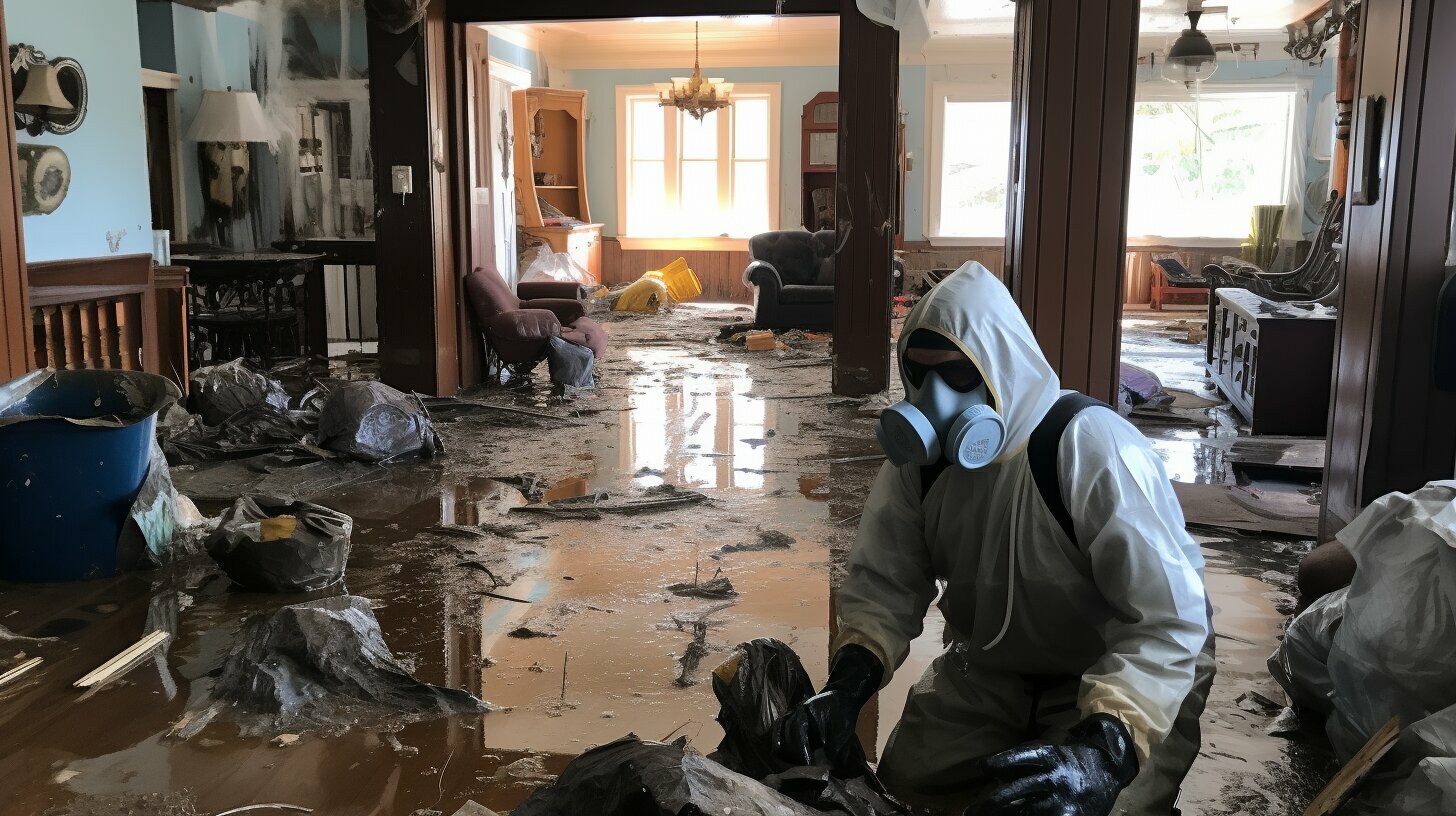When a flood damages your property, it’s crucial to act quickly. The longer you wait, the more severe the damage can become, leading to structural issues and health hazards. In this article, we’ll discuss expert tips for fast and effective flood damage restoration to help you recover as soon as possible.
Key Takeaways:
- Flood damage restoration requires fast action to prevent further damage and health hazards.
- Understanding the types of water damage and potential effects is crucial before starting the restoration process.
- Immediate steps are necessary to safeguard your property, including removing standing water, drying affected areas, and hiring a professional restoration company.
- Choosing a reliable flood restoration company with experienced professionals is essential for efficient and effective flood damage repair.
- The water damage restoration process involves assessing the damage, removing damaged materials, drying out the property, and restoring it to its pre-flood condition.
- Documenting the damage, working with insurance providers, and implementing preventive measures can help avoid future floods.
Understanding Flood Damage and Its Effects
When flood waters enter your property, they can cause severe damage that can affect your home’s structural integrity and create severe health hazards. Water damage from floods is a unique type of damage that requires specialized handling to ensure proper restoration. –
There are three types of water damage that floods can cause, and each requires a different type of restoration.
- Category One: Clean Water Damage – This type of water damage occurs when floodwaters come from a clean source, such as a broken water pipe or a leaking faucet. It isn’t hazardous to your health and can be restored without the need for extensive safety measures.
- Category Two: Gray Water Damage – This type of water damage occurs when floodwaters contain contaminants such as bacteria or chemicals. It can create health hazards and requires specialized equipment and handling to safely restore.
- Category Three: Black Water Damage – This type of water damage occurs when floodwaters contain toxic substances like raw sewage, chemicals, and other hazardous materials. It poses a severe health risk and requires extensive safety measures to protect people during restoration.
It’s important to note that flood damage can also cause hidden damage to your property, such as mold growth, which can lead to severe health problems. Therefore, it’s critical to assess the extent of the damage before starting restoration.
Steps to Safeguard Your Property After a Flood
Experiencing a flood can be overwhelming, but it’s crucial to take action quickly to prevent further damage to your property. Here are some essential steps to safeguard your property after a flood:
1. Ensure Safety
The first thing you should do is ensure your safety and that of your family members. Avoid standing in floodwater because the water could be contaminated or have electrical currents that could be dangerous. If you must enter the water, wear protective clothing and rubber boots to prevent any injury.
2. Remove Water
Once you have secured your safety, begin removing the water from your property. Use a pump or a wet-dry vacuum to remove the standing water. If the water is too deep, seek professional help from emergency flood cleanup services.
3. Dry Out Affected Areas
After removing the standing water, dry out the affected areas thoroughly. Open windows and doors to let air circulate, use fans to speed up the drying process, and consider renting a dehumidifier to remove any remaining moisture from the air. This will help prevent mold growth and further damage to your property.
4. Prevent Further Damage
Take necessary precautions to prevent further damage to your property. Turn off the electricity and gas, and unplug all appliances, if it’s safe to do so. Move your belongings to a dry area, and cover them with a plastic sheet to protect them from any water damage. Lastly, make sure to contact your insurance company as soon as possible and document all damage with photographs and videos.
5. Hire Professional Flood Damage Restoration Services
Although you can take some basic steps to prevent further damage, it’s essential to hire professional flood damage cleanup and water damage restoration services. These experts have the specialized equipment and expertise to dry out your property, remove the damaged materials, and restore your property to its pre-flood condition.
By following these steps, you can safeguard your property after a flood and minimize the damage. Remember, the key to successful flood damage restoration is acting quickly and hiring professional services.
Choosing a Reliable Flood Restoration Company
If you are dealing with flood damage in your property, it is important to hire a reliable flood restoration company to handle the repairs. While there may be numerous options available, it is crucial to research and choose a company with the necessary experience and expertise to get the job done right.
Start by asking for recommendations from friends, family or your insurance provider. You can also look for online reviews and check the company’s website for credentials and certifications.
When choosing a flood restoration company, make sure they have experience dealing with your specific type of flood damage. For instance, if you have experienced a sewage backup, make sure the company has experience dealing with sewage cleanup. A licensed company with trained professionals should also be willing to provide you with references from past clients.
Ensure the company you select is properly licensed and insured. This will protect you in case of any damages or accidents that may occur during the restoration process. Make sure the company conducts a thorough assessment of the damage and provides you with a detailed estimate of the cost and timeline for repairs.
Don’t be afraid to ask questions about the restoration process and the equipment and techniques they will be using. A reliable flood restoration company should be transparent and willing to answer any questions you have.
Restoring Your Property: The Water Damage Restoration Process
Once the extent of the flood damage has been assessed, the water damage restoration specialists will begin the process of restoring your property to its pre-flood condition. This process typically involves several steps:
1. Removing damaged materials: The first step is to remove any damaged materials including furniture, carpeting, and drywall. This will prevent further water damage and mold growth.
2. Drying out the property: After removing the damaged materials, the area needs to be thoroughly dried out. This may involve using dehumidifiers, fans, and specialized equipment to ensure that all moisture is removed from the building.
3. Cleaning and disinfecting: Once the property is dry, it will need to be cleaned and disinfected to prevent mold growth. This may involve using specialized cleaning agents to sanitize the affected areas.
4. Restoring the property: The final step is to restore the property to its pre-flood condition. This may involve replacing any damaged materials and repainting walls.
Throughout the water damage restoration process, the flood damage restoration experts will work closely with you to ensure that your property is restored quickly and efficiently. They will also help you navigate the insurance claims process to maximize your coverage and minimize your out-of-pocket expenses.
Remember, restoring your property after a flood can be a complex and time-consuming process. That’s why it’s important to hire experienced water damage restoration specialists or flood damage restoration experts to help you through this challenging time. With their expertise and skills, you can rest assured that your property will be restored to its pre-flood condition as quickly and efficiently as possible.
Additional Tips for Successful Flood Damage Restoration
When it comes to restoring your property after flood damage, there are several additional tips that can help ensure a successful restoration process:
Document the damage: Before beginning any restoration work, it’s important to document the damage for insurance purposes. Take photos and videos of the affected areas and keep a record of any damages or losses. This can help you receive proper compensation from your insurance provider.
Work with your insurance provider: Your insurance provider should be one of your first points of contact after a flood. Contact them to report the damage and find out what your policy covers. They can also recommend flood damage restoration companies that they work with.
Implement preventive measures: Once your property has been restored, it’s important to take steps to prevent future floods. This may include installing sump pumps, waterproofing your basement, or landscaping to divert water away from your property.
Hire professional flood damage restoration services: While it may be tempting to try to handle the restoration on your own, it’s important to hire professional flood damage restoration services. They have the expertise and equipment needed to properly assess the damage, remove any standing water, dry out the property, and restore it to its pre-flood condition.
Choose a reputable company: When choosing a flood restoration company, do your research to find a reputable and experienced provider. Look for companies with positive reviews and certifications from industry organizations.
Following these tips can help make the flood damage restoration process smoother and more successful. Remember to act quickly and hire the right professionals to ensure your property is restored to its pre-flood condition.







